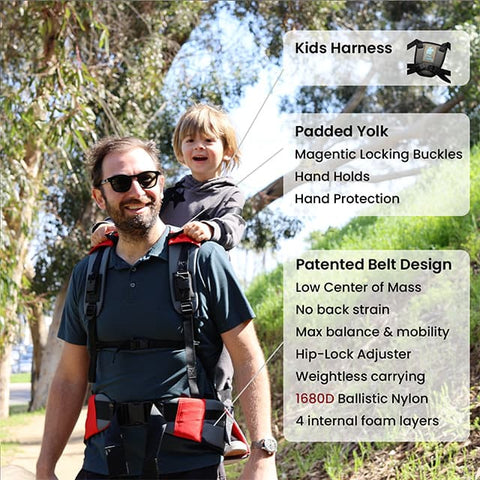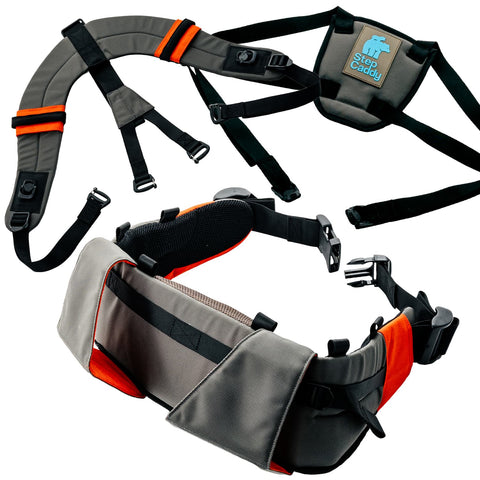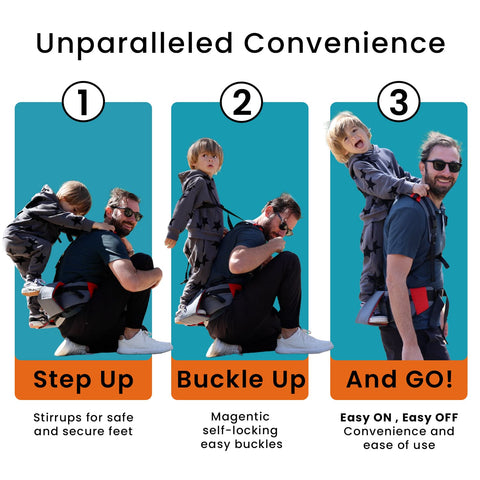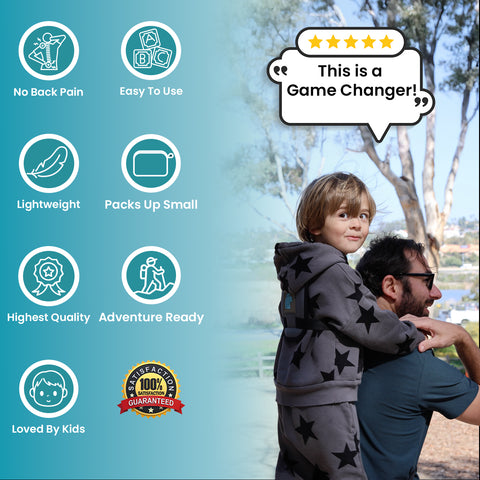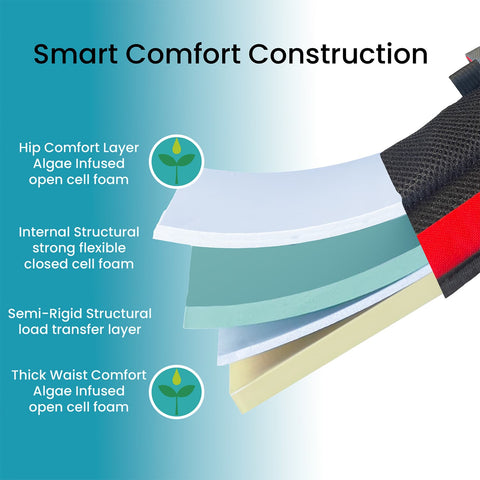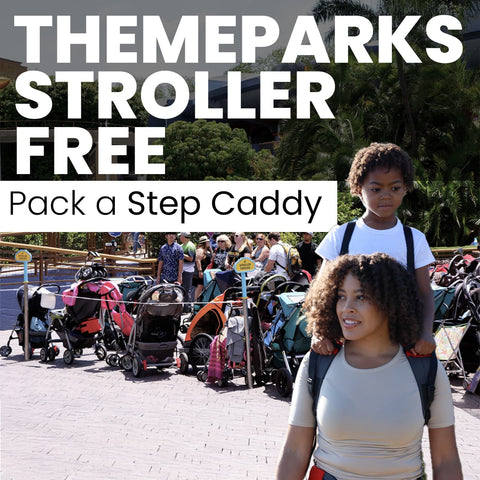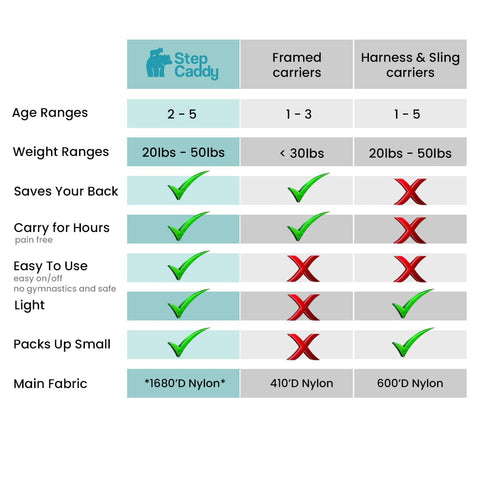You’re halfway through a long hike, your toddler or preschooler is tired, and your back is already sore from carrying. Perhaps you’ve tried a few bulky framed carriers or struggled with shoulder straps from old-school slings, but none have seemed comfortable for long. That’s where ergonomic child carriers change the game, and why Step Caddy’s standing piggyback carrier is earning rave reviews from parents with tired spines and energetic kids.
What Makes a Child Carrier “Ergonomic”?
If you’ve ever ended a family outing with a sore back, you’ll want to know what actually constitutes ergonomic design in a child carrier. In simple terms, an ergonomic carrier is designed with your body’s mechanics in mind. Instead of forcing your shoulders and spine to handle the child’s whole weight, ergonomic designs shift that load onto your hips, which are built to bear weight.
This hip-based support protects your back, improves your posture, and lets you move naturally—even with a 40-pound preschooler “helping” you finish those last uphill steps. Unlike old backpack-style carriers that pull you backward or soft-sided slings that leave your neck crooked, an ergonomic child carrier aims to feel almost “weightless” once it’s properly fastened.
How Step Caddy’s Design Protects Your Back
Step Caddy’s standing piggyback carrier was invented after years of wrestling with awkward, heavy alternatives. Here’s how its design turns a rough hauling job into a comfortable adventure:
- Patented Load-Bearing Waistbelt: All of your child’s weight transfers directly to your hips. Your shoulders and spine get a break, and there’s no slumping forward or tensing your back.
- Waistbelt Stirrups: Instead of dangling legs scratching up your sides or slipping off, Step Caddy has built-in stirrups for your child’s feet. These offer stable support and keep their weight centered, making every step steadier for both of you.
- Hip-Lock Straps: The carrier molds to your hips, optimizing comfort while maintaining efficient weight transfer.
- Self-Locking Magnetic Buckles: These are easy to close in your line of sight (no awkward reaching behind your neck) and lock automatically for peace of mind.
- Lightweight and Compact: Weighing just under 3 lbs, the entire carrier folds up compactly for travel, so you’re not lugging a camping pack around the zoo.
But don’t just take it from me. One parent shared, “I was absolutely blown away with how light my kid felt... you feel almost nothing on your shoulders or back. It was great for our hike, and is now essential gear for us.”
Why Hip-Based Weight Distribution Is a Game Changer
Traditional piggybacks, where your child holds your neck like a koala, load up your shoulders, strain your lower back, and throw off your center of gravity. Even most child carrier backpack models, while better than most, still put a lot of weight up high and outward, away from your center of mass.
Step Caddy stands out (literally) by positioning kids in a natural, upright piggyback stance. The difference? Your body acts like it’s wearing nothing more than a regular backpack, even with a squirmy four-year-old in tow. That gives you better balance and stamina for long walks, travel days, and wild family adventures.
Health professionals agree: keeping weight low and on the hips preserves natural spinal alignment and reduces the risk of chronic back pain. That’s why good hiking carriers for 4 year olds, or any big kid, prioritize hip-belt support and a standing carry over dangling-leg designs.
Ergonomic vs. Non-Ergonomic Carriers
It’s tempting to opt for a basic soft carrier or a metal-framed backpack carrier, especially if you’re accustomed to traditional brands. However, non-ergonomic carriers often have common drawbacks:
- Weight on Shoulders: Cheap designs usually force your upper body to take the burden, leading to early fatigue and sore muscles.
- Poor Posture: Non-ergonomic models can make you lean forward or arch your back unnaturally.
- Awkward Buckles and Straps: Fiddly closures placed behind your neck are tough to manage, especially with a wiggly child.
- Limited Adjustability: Many non-ergonomic options fail to fit well for all body types, resulting in discomfort during both short and long outings.
In contrast, the Step Caddy focuses on comfort for both parent and child, with careful adjustments, visible buckles, and a customizable fit so you’re not constantly shifting or struggling.
How Does a Standing Piggyback Carrier Reduce Back Strain?
The answer is biomechanics. When your child stands behind you with their weight supported at your hips, your body moves just as if you were carrying a simple hiking pack. There’s no upper body twist or shoulder
tension. Additionally, the standing piggyback carrier provides kids with a perfect view of the world, making outings more interactive and less fussy.
One reviewer put it best: “Unlike traditional child carriers, this carrier allows kids to stand while you walk, making hikes and walks so much more fun for them! My daughter loves it.”
That fun translates to longer adventures and fewer requests for breaks.
If you’re looking for even more info on different carrier types, check out our full comparison on piggyback carriers.
- Piggyback Riding: Guide to Safe, Smart, and Fun Child Carriers
- Standing Piggyback Carrier vs. Traditional Carriers
- Child Carriers That Can Save Your Spine (2025)
Let’s be honest—“best” can sound like a big promise. But if you’re struggling with back pain, Step Caddy was designed specifically for you. Everything about its shape, straps, and safety features stems from years of trial, biomechanical science, and extensive real-world testing. The difference shows up on your first outing: Less pain, more freedom, and a lot more smiling from both you and your kid.
It’s easy to see why so many parents call it a “game changer.” It even works as a backup when strollers can’t go: crowded theme parks, city sidewalks, and forest trails suddenly become accessible again. Because it’s a genuinely lightweight carrier, you won’t dread packing it on your next family trip.
Take Your Kid Further—Without the Backache
Ergonomic child carriers aren’t just a buzzword; they’re a tool for making family life more fun and less painful. With Step Caddy’s clever design—load-bearing waistbelt, easy-on buckles, secure stirrups—you can adventure further without the aches and enjoy more moments with your little explorer.
Ready to start your next outing pain-free? Discover how Step Caddy compares, or explore options for a carrier backpack that prioritizes your comfort. Your back (and your kid) will thank you!



